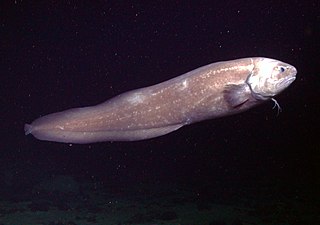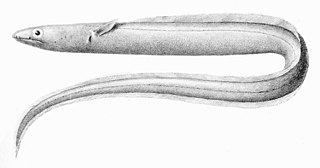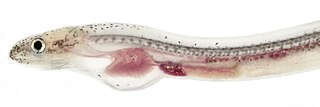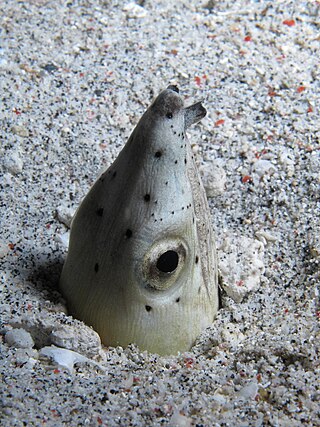
Ophichthidae is a family of fish in the order Anguilliformes, commonly known as the snake eels. The term "Ophichthidae" comes from Greek ophis ("serpent") and ichthys ("fish"). Snake eels are also burrowing eels. They are named for their physical appearance, as they have long, cylindrical, snake-like bodies. This family is found worldwide in tropical to warm temperate waters. They inhabit a wide range of habitats, from coastal shallows and even rivers, to depths below 800 m (2,600 ft). Most species are bottom dwellers, hiding in mud or sand to capture their prey of crustaceans and small fish, but some are pelagic.

The cusk-eel family, Ophidiidae, is a group of marine bony fishes in the Ophidiiformes order. The scientific name is from the Greek ophis meaning "snake", and refers to their eel-like appearance. True eels diverged from other ray-finned fish during the Jurassic, while cusk-eels are part of the Percomorpha clade, along with tuna, perch, seahorses and others.

Uropterygius is a genus of moray eels in the family Muraenidae.

Myrichthys is a genus of snake eels currently containing 11 recognized species found in tropical and warm temperate oceans worldwide.

Eels are ray-finned fish belonging to the order Anguilliformes, which consists of eight suborders, 20 families, 164 genera, and about 1000 species. Eels undergo considerable development from the early larval stage to the eventual adult stage and are usually predators.

Callechelys is a genus of eels in the snake eel family Ophichthidae. It currently contains the following fifteen species:

Echelus is a genus of eels in the snake-eel family Ophichthidae.
Ichthyapus is a genus of eels in the snake eel family Ophichthidae.

Myrophis is a genus of eels in the snake eel family Ophichthidae.

Ophichthus is a genus of eels in the snake eel family Ophichthidae.

Pisodonophis is a genus of eels in the snake eel family Ophichthidae. It currently contains the following species:
Yirrkala is a genus of eels in the snake eel family Ophichthidae. It is named after Yirrkala, an indigenous community in Arnhem Land, in the Northern Territory of Australia.

Aplatophis chauliodus, the fangtooth snake-eel, also known as the tusky eel in Cuba and the United States, is an eel in the family Ophichthidae. It was described by James Erwin Böhlke in 1956. It is a marine, tropical eel known from the western Atlantic Ocean, including the Gulf of Mexico and French Guiana. It is also known to occur on the northeastern coast of Brasil. It dwells at a depth range of 33–91 m (100–300 ft), and dwells in both marine waters and brackish estuaries. It inhabits burrows on a permanent or semipermanent basis, and leaves its eyes and snout exposed. Males can reach a maximum total length of 84 cm (33 in). The fangtooth snake-eel's diet consists of bony fish and crustaceans.
The snaggle-toothed snake-eel is an eel in the family Ophichthidae. It was described by John E. McCosker and David Ross Robertson in 2001. It is a marine, tropical eel which is known from a single specimen collected from Panama, in the eastern central Pacific Ocean. From the specimen it is known to dwell at a depth range of 5–10 metres, and reach a maximum total length of 104 centimetres. Based on other eel species it is estimated to inhabit burrows on a permanent or semi-permanent basis, and feed on small fish and crustaceans.

The goldspotted eel, also known as the goldspotted snake eel or the dark-spotted snake eel, is an eel in the family Ophichthidae. It was described by Charles Alexandre Lesueur in 1825, originally under the genus Muraenophis. It is a marine, tropical eel which is known from the western and eastern Atlantic Ocean, including Bermuda, southern Florida, USA; the Bahamas, Santa Catarina, and Brazil. It dwells at a maximum depth of 15 metres (49 ft), and inhabits rocky and coral reefs. Males can reach a maximum total length of 110 centimetres (3.6 ft).

The highfin snake eel (Ophichthus altipennis, also known as the blackfin snake eel or the black-finned snake eel, is an eel in the family Ophichthidae. It was described by Johann Jakob Kaup in 1856, originally under the genus Microdonophis. It is a marine, tropical eel known from the eastern Indian Ocean and northwestern and western central Pacific Ocean, including Australia, French Polynesia, Indonesia, Japan, the Marshall Islands, Malaysia, the Philippines, and Papua New Guinea. It dwells at a depth range of 0 to 40 m, and forms burrows in soft inshore sand sediments. Males can reach a maximum total length of 103 cm.
The faintsaddled snake eel is an eel in the family Ophichthidae. It was described by John E. McCosker and Eugenia Brandt Böhlke in 1984. It is a marine, temperate water-dwelling eel which is known from the western central Atlantic Ocean. It is known to dwell at a depth of 108 meters.
The longarmed snake eel is an eel in the family Ophichthidae. It was described by John E. McCosker and Richard Heinrich Rosenblatt in 1998. It is a marine, tropical eel which is known from the eastern central Pacific Ocean, including Mexico, Costa Rica, El Salvador, Guatemala, Nicaragua, and Panama. It is known to dwell at a depth range of 24 to 79 metres, and inhabits soft substrates. Males can reach a maximum total length of 27.4 centimetres (10.8 in).
The dottedline snake eel is a species of eels in the family Ophichthidae. It was described by John E. McCosker and Eugenia Brandt Böhlke in 1984. It is a marine, temperate water-dwelling eel which is known from the western central Atlantic Ocean. It is known to dwell at a depth of 183 meters.

The rice-paddy eel is an eel in the family Ophichthidae. It was described by Francis Buchanan-Hamilton in 1822, originally in the genus Ophisurus. It is a tropical, marine eel which is known from the Indo-West Pacific, including Somalia, Tanzania, South Africa, India, Pakistan, Sri Lanka, Indonesia, Polynesia, Australia, Bangladesh, Cambodia, Kenya, Madagascar, the Philippines, Malaysia, Mozambique, Seychelles, Saudi Arabia, Taiwan, China, Thailand, Vietnam, and southern Yemen. It is an anadromous species and spawns in freshwater, often in rice paddies during the rainy season, earning it its common name. It also spends time in lagoons, estuaries and coastal rivers, in which it lives in burrows in the river bottom and bank. Males can reach a maximum total length (TL) of 100 centimetres, but more commonly reach a TL of 70 cm.












